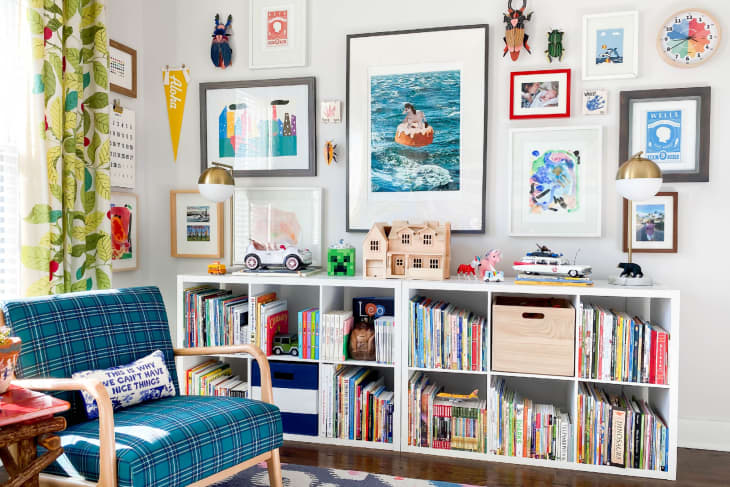A Few Simple Tips for Designing an All-Purpose Space That Kids and Adults Will Use Every Day
This piece was created for Cubby, our weekly newsletter for families at home. Want more? Sign up here for a weekly splash of fun and good ideas for families with kids. Join us over on Instagram for more!
Cubby. Real solutions for unreal times.
Join us for a weekly dose of fresh, modern ideas for life at home with your kids.
I think it’s pretty safe to assume every parent wants to raise self-aware children who have a developed sense of competence. Of course, that comes about through ongoing verbal exchanges between parents and children. But what about nonverbal messages children receive from home about their value and abilities?
Interiors are a major source of these nonverbal messages; and according to design psychology, our earliest experiences with home have the power to shape our sensibilities. When we have a home that fulfills our psychological need for love and belonging, it goes a long way in making us feel valued, which in turn fosters a sense of competence. Interior designer of Mary Kathryn Wells Interior Design, Mary Kathryn Wells agrees. “It used to be considered a high compliment for people to say ‘you never know children live here,” says Wells, but “in order to grow into well-adjusted, competent humans, children need to feel seen in their own home.”
So let’s create a sense of competence for our kiddos by giving them a home that validates them. Here’s how:
Mix up kids’ and adults’ furnishings for scale and functionality
Virginia Johnson, textile designer and author of Travels Through the French Riviera, says “Designing a space that is stylish for adults yet kid-friendly doesn’t have to be a compromise.” Incorporate furniture that kids and adults can use to make everyone feel a sense of belonging. Johnson focused on creating a bookshelf that could grow with her children. “Initially the bottom shelves were outfitted to house storage bins for toys and as our children grew, they became places to store books and board games.”
Incorporating kid-sized furniture into the main living area is another fun way to make sure everyone feels a sense of belonging. It’s much easier to find attractive, child furnishings than in the past. Lara Garcia, graphic designer and founder of The Mood Guide prefers a more calming space for adults and kids. She proposes mixing the lines of the furniture to balance out the design. “Soothing, organic shapes mixed with more serious, straight lines evoke the visual and emotional balance between childhood innocence and adult sophistication,” she says. Garcia also suggests using neutral colors, if you are looking for a more timeless feel. “I recommend using white and gray to create a space that is chic and appealing to everyone.”
Celebrate pattern and color by displaying kids’ artwork prominently
If, however, your taste leans towards bolder colors, don’t shy away from them. Wells specializes in creating spaces both children and adults can enjoy. “The space is so much more vibrant when you really celebrate everyone in the design,” she says. One simple way she proposes doing this is by hanging kids’ artwork throughout the home. If you’re concerned about the art fitting in, Wells suggests using colors that work in your home. “If all fails, give them black tempera paint cakes and a one-inch foam brush,” she adds.
For fabrics, Wells recommends using a lot of color and pattern. “[Colorful fabrics] are great not only for bringing a space to life,” she says, “but also for making stains and spills harder to see.” Johnson took a carefree approach to textiles: “I didn’t compromise … I chose colorful textiles, and they survived better than expected!”
Rooms are more playful with small, unexpected elements, like — yes — plastic toys!
Johnson says, “Rooms shouldn’t take themselves too seriously.” In other words, try adding an unexpected element, such as an orange plastic dinosaur on your coffee table. Wells did just that, and says it “adds some fun and punchiness” to her living room décor. Wells doesn’t recommend displaying just any toy in the living space, but ones that blend well with the space, like baskets full of toy cars.
Wells also enjoys including kids’ books on the coffee table that adults will get a kick out of too. “What adult doesn’t want to learn something about Frida Kahlo or read ‘Your Inner Critic is a Big Jerk?’” she asks.
(Fun fact: the art hanging over the mantle in the living room was painted by Wells’ now-8-year-old son when he was 3).
Pair the statement-making luxe items with more affordable, basic ones
As parents, we want our rooms to look nice and yet be affordable, right? Wells recommends strategizing about saving and splurging. She suggests spending more on certain kids’ furnishings if it will be part of the living space; and pairing it with something more affordable, like the small table that goes with the pricier, statement-making bunny chairs in her own home. “You can also buy modestly priced lamps, and spend more money on lampshades,” says Wells.
Be cautious with breakables — but not too precious
When considering what to do about breakable items, Wells offers, “You can have breakable things, but put them up higher on a mantle or on display shelves.” All in all, she warns against comparing your home to perfectly styled homes seen in magazines. “Our homes aren’t going to be perfect .… That’s a sign of a life being lived. Have a sense of humor and embrace imperfection. The images you see online are styled for a photo shoot.”
